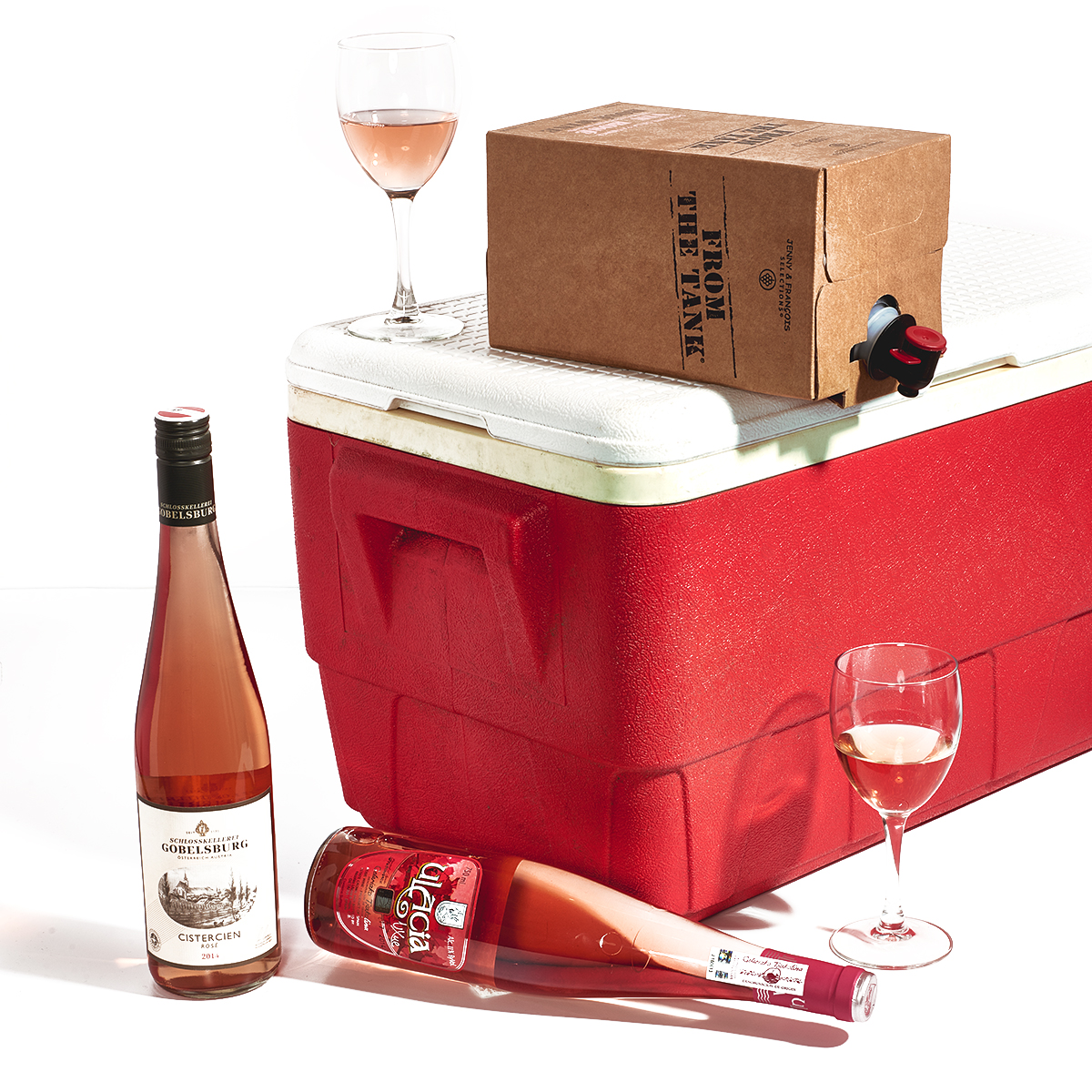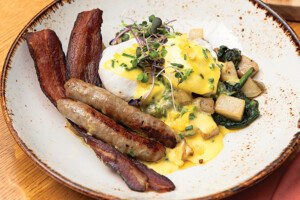12 Rosés to Seek Out This Spring

Photo by Toan Trinh
A decade ago, sommeliers and other wine professionals embraced the slogan “Drink Pink” as they sought to reverse the damage wrought by white zinfandel, Beringer White Merlot, and its similarly saccharine brethren. Now rosés have become a harbinger for patio season, having shirked its cruel association with cheap boxes of blush. In fact, rosés have become so sought-after that some retailers are now looking to sell them before the wines are even in bottle. We’re in the midst of full-blown rosé fever, which in turn has meant an influx of clunky, ersatz pink wine—a pale imitation of the delicate, thirst-slaking Provençal examples that made us fall in love with the category in the first place.
To help us navigate this growing, yet precarious new phenomenon, we’ve asked some of the city’s most seasoned wine experts to give us their picks for the can’t-miss bottles to drink during Boston’s all-too-brief al fresco season. Their answers ranged from orange-tinted patio pounders and effervescent Txakolis to one Old World Rhone blend swaddled in an unassuming cardboard box. Here, in their own words, the 12 labels you’ll want to see on every wine list, not to mention at-ready in the back of your fridge.
Tegernseerhof Zweigelt Rosé
Origin: Wachau, Austria
Chosen by: Liz Vilardi, Belly Wine Bar
I really love Tegernseerhof’s rieslings, and I think they bring that same high-acid, dry style to their rosé of Zweigelt. The wine is racy and sophisticated, almost effervescent with the slightest hint of ripe red fruits. Not only is it tangy, but it makes you salivate. It’s truly lovely stuff, and a versatile food wine as well. You can eat anything with it or you can just guzzle it down on the porch with friends.
Forlorn Hope “Ukiyo”
Origin: Sierra Foothills, California
Chosen by: Liz Vilardi, Belly Wine Bar
I am absolutely mad about Matthew Rorick. I love the Forlorn Hope wines in general, but I really love that he made a rosé of Amador County Touriga Nacional, Tinta Roriz, Tinto Cão, and Trincadeira—all from the Dewitt vineyard. He leaves it in barrel for eight months and whoa is it seductive. It’s plush with a briny acidity in the finish. Only 297 cases were made and I second guess putting it on my list [at Belly] every time I have to crack open a new case. I just love, love, love it!
Pascal Jolivet Sancerre Rose
Origin: Loire Valley, France
Chosen by: Jillian Rocco, Row 34
I’m crazy about Pascal Jolivet Sancerre Rose this season. It’s energetic, bright, crisp, lively, and charming. Pinot Noir is everyone’s go-to grape, so experiencing this iteration of it is really fun. I love turning guests on to a different shade of Pinot Noir. And Sancerre’s cache is easy to capitalize on. I mean, who doesn’t love mineral-driven, high acid wine on a warm day?
Ulacia Getariako Txakolina
Origin: Basque, Spain
Chosen by: Michael Dupuy, Streetcar Wine
Not only is Ulacia great, but it’s something other than Ameztoi Rubentis. People need to see that there are other wonderful Txakolis being produced in Spain. Ameztoi seems to have captured the hearts and minds of Bostonians everywhere, to the point that it’s way oversold even before it arrives stateside. Made from Hondarrabi Beltza and Hondarrabi Zuri, Ulacia is super refreshing and has that classic Txakoli spritz to it. There’s beautiful strawberry and kiwi fruit notes and the finish is nice and dry.
Domaine de la Patience From the Tank
Origin: Costieres de Nimes, France
Chosen by: Michael Dupuy, Streetcar Wine
This might not be the most photogenic wine, seeing as how it’s packaged in a generic brown cardboard box. But it’s really good! It’s actually one of our best-selling wines every summer. It’s a fresh, classic Mediterranean-style rose made from old vine Grenache and Syrah. Plus, one box is the equivalent of four bottles of wine. What’s better than rosé? More rosé.
Lioco “Indica” Carignan Rose
Origin: Mendocino, California
Chosen by: Theresa Paopao, Ribelle
Matt Licklider and Kevin O’Connor are fantastic winemakers who both started off as sommeliers at Wolfgang Puck’s restaurants in the 1980s. During their time there, they always had a hard time finding California wines that they liked. So, when they left the restaurant industry, they decided to start making wine in an effort to show that the West Coast could produce wines with grace and acidity. When you think of rosé, you normally associate it with all kinds of berry flavors, but this is extremely dry and has really racy acidity. It straight up tastes like rhubarb and pink lemonade.
Edmunds St. John “Bone Jolly” Rose of Gamay
Origin: El Dorado, California
Chosen by: Jen Fields, Alden & Harlow
Edmunds St. John is a French-inspired, small-production, terroir-driven winery based out of Berkley, California. They make a few different offerings from single vineyard sites around the state, but the “Bone Jolly” rosé of Gamay is always one of my favorites. The intense pink, burnt orange hues really mimic the flavor profile of smoke, tart red fruits, and blood oranges. It’s bold and brawny with plenty of juicy acidity, which makes it drinkable on its own, but also a wonderful pairing for a large variety of foods.
Bedrock Wine Co. “Ode To Lulu” Mourvedre
Origin: Sonoma Valley, California
Chosen by: Jen Fields, Alden & Harlow
While “Ode to Lulu” wants to honor its Old World roots in varietal and style—even the name is an homage to a well-respected producer in Bandol—the winemaker, Morgan Twain Teterson, still wants it to taste like it’s from California. Old vine Mourvedre is picked exclusively for this rose, and whole-cluster fermented to produce a salmon hued wine with notes of earthy strawberry and melon. It’s a crisp, medium-bodied sipper that will pair well with most lighter summer dishes, but could definitely hold up to a hot dog as well.
Schloss Gobelsburg
Origin: Osterreich, Austria
Chosen by: Felisha Foster, Spoke Wine Bar
I love the history here: how having founded a monastery in 1074, the monks of Zwettl Abbey were granted their first vineyards, Heiligenstein & Gaisberg—the oldest documented sites in the Kamptal. The estate and Castle Gobelsburg was controlled by as many as 19 different families between 1074 and 1740. Eva and Michael Moosbrugger were granted the winemaking and viticultural contract in 1996. This blend of Pinot Noir, Zweigelt, and St. Laurent has wild cherry and bright berry nuances, with a mouthwatering tang. It has a great balance of fruit and acidity.
Meinklang Frizzante
Origin: Burgenland, Austria
Chosen by: Felisha Foster, Spoke Wine Bar
This is what I like to call a patio pounder. A certified biodynamic Pinot Noir rosé, Meinklang showcases ripe summer fruits like strawberries and raspberries. This wine always wakes my palate up and makes me happy. At 11-percent ABV, it’s also super crushable.
Cote Mas “Aurore” Rose
Origin: Rhone Valley, France
Chosen by: Dan Lech, Ball Square Fine Wine
Provence may be the holy land of dry rosé, but just up the road in the Languedoc you can find pale pink beauties of similar character, with pleasantly dissimilar prices. This liter-sized, screw-cap finished blend of Grenache, Syrah, and Cinsault from Domaine Paul Mas captures the essence of great rose: crushed strawberry fruit, lithe minerality, and a bracingly dry finish, all for under $12.
Calcu Rose Reserva
Origin: Colchagua Valley, Chile
Chosen by: Dan Lech, Ball Square Fine Wine
As the rosé floodgates have opened, and nearly every winery in the world is now going pink, one has to be diligent and discerning in order to avoid over-fruited imposters. This unusual blend of Malbec, Syrah, and Petit Verdot is surprisingly pale in color and delightfully elegant in its restrained fruit presentation. The terroir of Chile is an intriguing and unobtrusive accent in an otherwise very traditional dry rosé.


